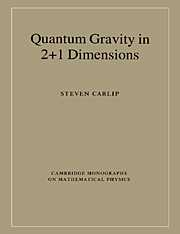Book contents
- Frontmatter
- Contents
- Preface
- 1 Why (2+1)-dimensional gravity?
- 2 Classical general relativity in 2+1 dimensions
- 3 A field guide to the (2+1)-dimensional spacetimes
- 4 Geometric structures and Chern–Simons theory
- 5 Canonical quantization in reduced phase space
- 6 The connection representation
- 7 Operator algebras and loops
- 8 The Wheeler–DeWitt equation
- 9 Lorentzian path integrals
- 10 Euclidean path integrals and quantum cosmology
- 11 Lattice methods
- 12 The (2+1)-dimensional black hole
- 13 Next steps
- Appendix A The topology of manifolds
- Appendix B Lorentzian metrics and causal structure
- Appendix C Differential geometry and fiber bundles
- References
- Index
6 - The connection representation
Published online by Cambridge University Press: 15 December 2009
- Frontmatter
- Contents
- Preface
- 1 Why (2+1)-dimensional gravity?
- 2 Classical general relativity in 2+1 dimensions
- 3 A field guide to the (2+1)-dimensional spacetimes
- 4 Geometric structures and Chern–Simons theory
- 5 Canonical quantization in reduced phase space
- 6 The connection representation
- 7 Operator algebras and loops
- 8 The Wheeler–DeWitt equation
- 9 Lorentzian path integrals
- 10 Euclidean path integrals and quantum cosmology
- 11 Lattice methods
- 12 The (2+1)-dimensional black hole
- 13 Next steps
- Appendix A The topology of manifolds
- Appendix B Lorentzian metrics and causal structure
- Appendix C Differential geometry and fiber bundles
- References
- Index
Summary
The quantum theory of the preceding chapter grew out of the ADM formulation of classical (2+1)-dimensional gravity. As we saw in chapter 4, however, the classical theory can be described equally well in terms of geometric structures and the holonomies of flat connections. The two classical descriptions are ultimately equivalent, but they are quite different in spirit: the ADM formalism depicts a spatial geometry evolving in time, while the geometric structure formalism views the entire spacetime as a single ‘timeless’ entity.
The corresponding quantum theories are just as different. In particular, while ADM quantization incorporates a clearly defined time variable, the quantum theory of geometric structures, which we shall develop in this chapter, will be a ‘quantum gravity without time’. Nevertheless, the two quantum theories, like their classical counterparts, are closely related: the quantum theory of geometric structures will turn out to be a sort of ‘Heisenberg picture’ that complements the ‘Schrödinger picture’ of ADM quantization.
The approach of this chapter is commonly called the connection representation, and closely resembles the (3+1)-dimensional connection representation developed by Ashtekar et al. The name comes from the fact that the basic variables – in this case, the geometric structures of chapter 4 – are associated with the spin connection rather than the metric. In particular, the ‘configuration space’ of geometric structures is the space of SO(2,1) holonomies of the spin connection.
Covariant phase space
Our starting point for this chapter is the classical description of (2+1)-dimensional gravity developed in chapter 4.
- Type
- Chapter
- Information
- Quantum Gravity in 2+1 Dimensions , pp. 100 - 116Publisher: Cambridge University PressPrint publication year: 1998

